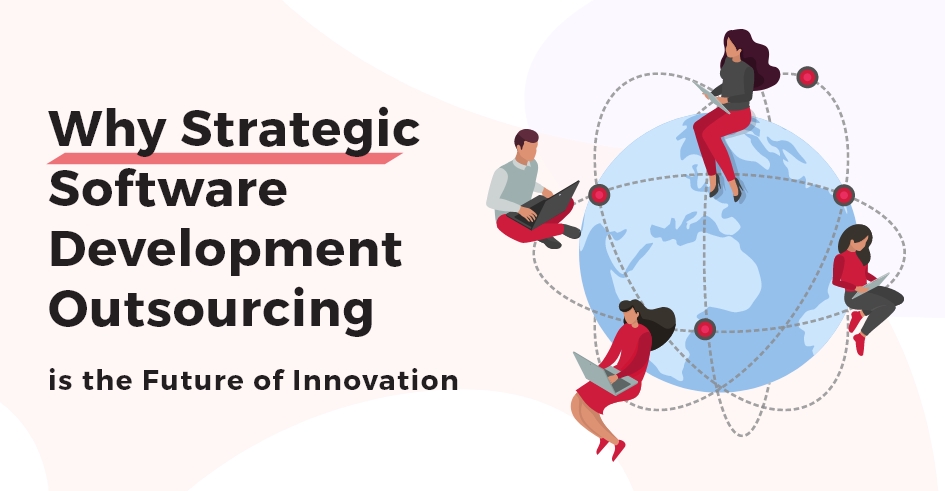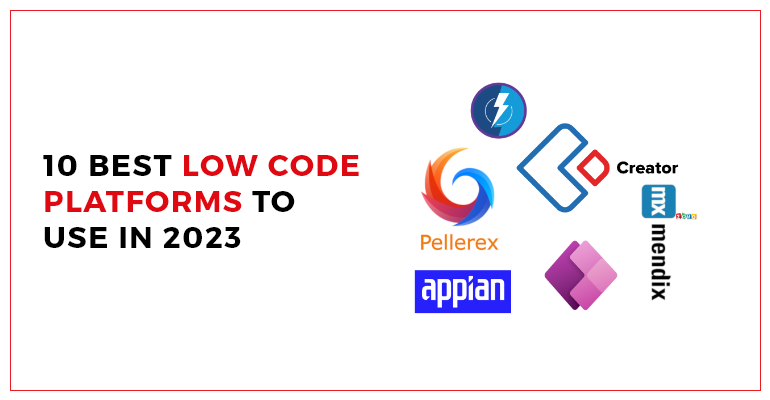In 2024, Software Development Outsourcing emerged as a strategic move that not only saves costs but drives real, cutting-edge innovation. But what’s next? The future lies not just in software development outsourcing but also in strategic outsourcing. This will be achieved by having access to global talent pools in ways that align with both current and future technological trends.
In this blog, we explore why strategic software development outsourcing is important for businesses aiming to innovate, how it’s evolving, and what 2025 holds for those who are ready to seize the opportunities. Let’s dive into the practical steps, unique outsourcing models, and tech-driven future shaping this industry.
What Is Software Development Outsourcing?
Imagine this: You’re gearing up to launch a new iOS app or custom software product. But suddenly, you realize you’re short on developers or maybe lack the expertise for a specific task.
What do you do? Do you scramble to hire full-time staff? Delay the project? Or do you look for a solution that doesn’t tie you down? That’s where Software Development Outsourcing comes in. It’s like calling in a team when you need it most without committing to them being around forever.
Software Development Outsourcing is the practice of hiring external developers, either from agencies or freelancers, to work on your project instead of using your internal team. In simple words, you’re outsourcing complex coding and development tasks to an expert software development company. You get the expertise without the full-time employee costs or long-term commitments.
And the best part? With outsourcing, you can start small. You don’t need to assemble an army of coders overnight. Maybe your in-house team is great at front-end work, but you need a back-end specialist or someone to handle DevOps. With outsourcing, you get access to exactly what you need, just when you need it.
Take TechnBrains, for example. We specialize in building custom development teams based on your exact needs. Whether you’re a startup or a well-established enterprise, we provide expert developers from around the world, giving you access to a flexible and scalable workforce.
Why Does Software Development Outsourcing Work?
Because it’s flexible, scalable, and efficient, just think about it. Would you rather spend months hiring, onboarding, and training new developers? Or would you prefer to have a team of experts jump in and start coding within a week? Software Development Outsourcing helps businesses avoid delays, allowing them to launch products faster and stay competitive. Plus, you don’t have to worry about benefits, office space, or HR hassles.

Outsourcing software development offers several advantages that can help your business model. For starters, Software Development Outsourcing allows you to tap into a global talent pool without the overhead costs of hiring in-house developers. Even if you need to scale up or down, Software Development Outsourcing provides flexibility in terms of team size and skillset.
Moreover, Software Development Outsourcing accelerates time to market. By a software outsourcing team, you reduce the time it takes to complete projects. These developers are often well-versed in agile methodologies and rapid development practices.
Finally, Software Development Outsourcing helps businesses significantly reduce costs. Instead of hiring full-time developers, companies can work with external teams on a project-by-project basis. This will help you optimize resource allocation and minimizes long-term commitments.
Outsourcing Software Development Pros and Cons
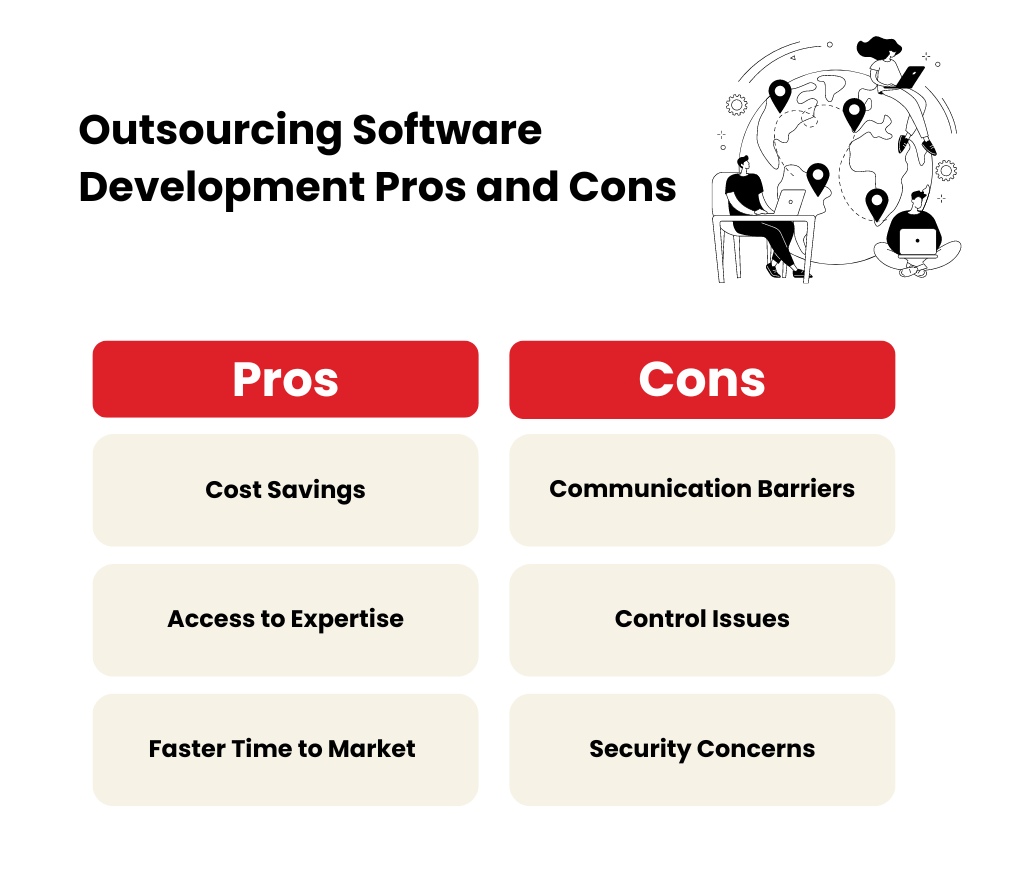
Just like any business decision, outsourcing software development has its pros and cons.
Advantages of Software Development Outsourcing:
- Cost Savings: Software Development Outsourcing eliminates the expenses related to hiring, training, and maintaining an in-house development team. You pay for only what you need.
- Access to Expertise: You gain access to skilled developers worldwide, each specializing in different technologies and methodologies.
- Faster Time to Market: Software Development Outsourcing helps speed up the development process by allowing you to add resources quickly and work around the clock in different time zones.
Disadvantages of Software Development Outsourcing:
- Communication Barriers: Working with a team in another region might result in language barriers or miscommunication, impacting project progress.
- Control Issues: You won’t have the same level of oversight as you would with an in-house team, which could result in delays or quality issues.
- Security Concerns: Sharing sensitive information with an external team could present security risks if proper protocols aren’t followed.
Despite the cons, companies that carefully vet their Software Development Outsourcing partners and maintain transparent communication can mitigate most risks while reaping the benefits of a skilled, external development team.

Outsourcing Software Development for Startups
Software Development Outsourcing can be a step into innovation for startups. Limited by both time and resources, startups often need help to build an in-house team quickly. Software Development Outsourcing allows them to hit the ground running without the lengthy hiring process.
Additionally, Software Development Outsourcing lets startups focus on their core competencies. Be it marketing, sales, or app monetization strategy, hiring mobile app developers will save you precious time. This is particularly helpful for non-technical founders who need to bring their vision to life without becoming bogged down in coding.
A famous example is Snapchat. An app like Snapchat successfully outsourced a significant portion of its development to a team in Eastern Europe during its early stages. This helped them rapidly develop the app while keeping costs low, Today, Snapchat has over 500 million users, proving that outsourcing can be a winning strategy for fast-growing startups.
2025 and Beyond: The Future of Software Development Outsourcing
While 2024 sees companies embracing Software Development Outsourcing as a way to gain competitive advantages, what about 2025?
Experts predict that by 2025, outsourcing will not only be about cost-effectiveness and time zones but will focus on innovation-led partnerships, AI integration, and quantum computing-ready teams.
We’re already witnessing trends like AI-driven outsourcing models, where companies utilize machine learning algorithms to optimize the selection of development teams. By 2025, AI’s role will expand further, driving efficiency and even predictive risk assessment in Software Development Outsourcing contracts. Moreover, quantum computing is on the horizon. Early adopters of software outsourcing solutions will be primed for these future technological leaps.
Software Development Outsourcing Models
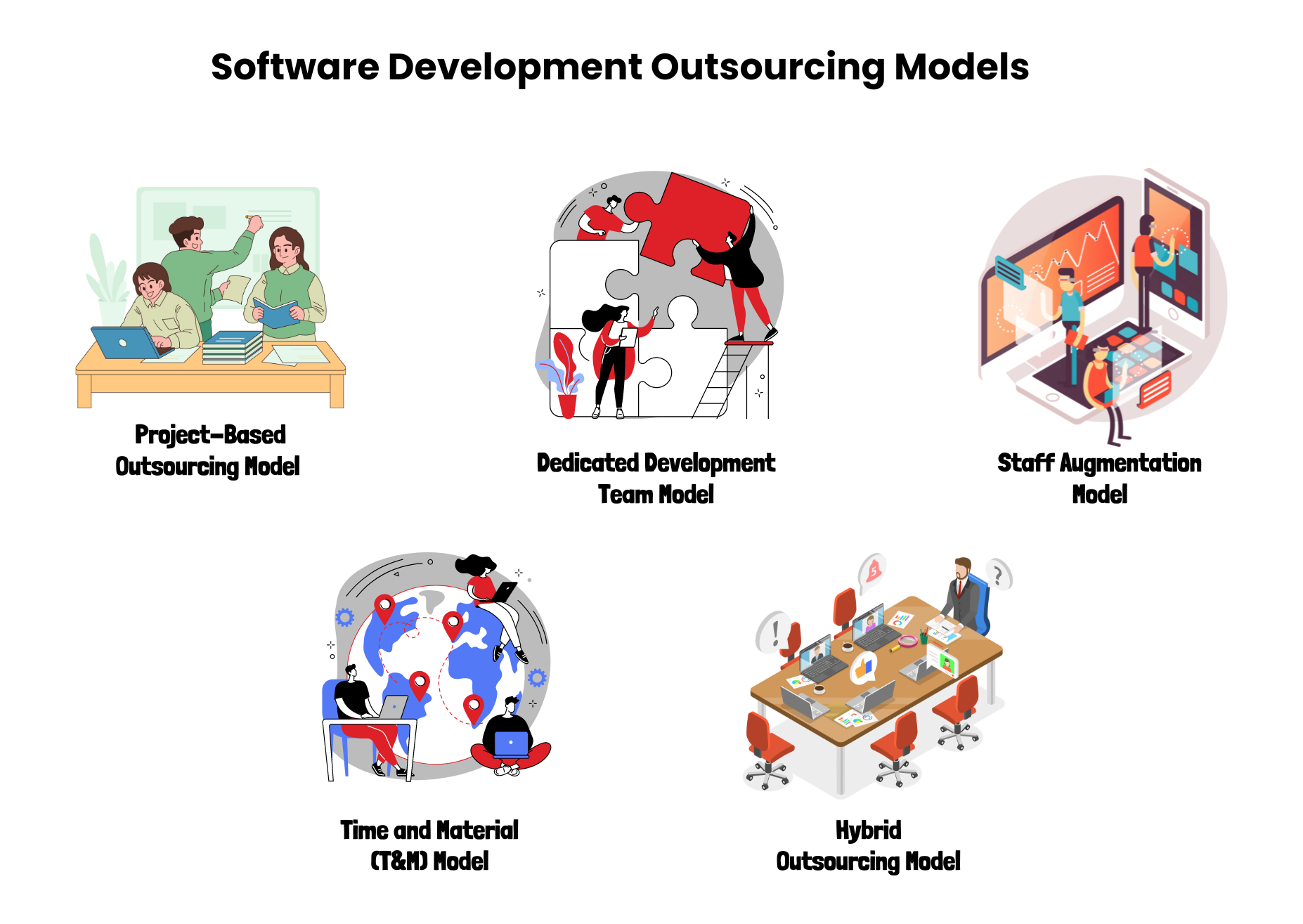
When it comes to Software Development Outsourcing, there’s no one-size-fits-all approach. Different businesses have different needs. This is the innovation leap you get with Software Development Outsourcing only. To help you choose the right path for your business, let’s explore the main outsourcing models and how they work.
1. Project-Based Outsourcing Model
A project-based outsourcing model is like commissioning a custom enterprise software solution. You provide a clear vision for what your company needs and the external development team takes care of everything—from planning and design to deployment and testing. You don’t have to worry about every detail or step of the process. It’s a “set it and forget it” approach, allowing you to focus on your core business.
This model is ideal for short-term or highly specialized enterprise app projects where hiring full-time developers doesn’t make sense. For example, if your business wants to create a custom CRM system or an internal enterprise mobile app to streamline operations, but you don’t have the in-house expertise, outsourcing the entire project can be a cost-effective, fast solution.
2. Dedicated Development Team Model
A dedicated development team is like having an extension of your in-house team but without the overhead. The dedicated development team model gives you a full team of developers, designers, and project managers who work solely on your projects. They integrate with your internal team and are focused exclusively on your goals.
The beauty here is the consistency. You get a team that understands your long-term vision and is aligned with your company’s processes. It’s like hiring full-time employees, but they remain on the payroll of the outsourcing vendor.
A dedicated development team is best for long-term projects, companies scaling their operations, or businesses that need specialized skills.
3. Staff Augmentation Model
This model is like hiring temporary workers for a construction project. You have an in-house team, but there’s a shortfall of skills or manpower for certain tasks. That’s where staff augmentation comes in. It allows you to hire external developers on a short-term or long-term basis to fill the gaps in your current workforce. TechnBrains offers staff augmentation services at a highly competitive rate of only $99 per day, making it a cost-effective solution to scale your development team quickly. This model is ideal for companies with an in-house team that needs additional help with specific skills or tasks without the commitment of long-term hiring.
4. Time and Material (T&M) Model
Think of this model as hiring a freelancer by the hour. In the Time and Material model, you pay for the actual time and resources spent on your project. This gives you a lot of flexibility, especially for projects where the scope isn’t well-defined or might change along the way.
It’s like when you’re doing home renovations, and you don’t know how much it’s going to cost exactly until you get into the nitty-gritty of it. You pay as the work progresses, which can be cost-effective if you only need part-time or on-demand developers.
The T&M model is best for Projects with uncertain scopes or companies that need flexibility as the project evolves.
5. Hybrid Outsourcing Model
Why choose one when you can have the best of both worlds? The hybrid outsourcing model blends both in-house and outsourced teams, allowing businesses to retain core tasks in-house while outsourcing specific aspects of the development process. This way, you can have an internal team managing critical operations while a trusted outsourcing partner handles the rest.
The hybrid model offers both flexibility and control, which makes it ideal for businesses that want to be involved but still offload part of the work. The hybrid outsourcing model is best for companies that want to balance control with cost efficiency.
Practical Guide to Strategic Software Development Outsourcing
Many companies struggle to outsource software development effectively. Here’s a step-by-step framework to ensure success:
Step 1: Define Clear Objectives
Before jumping into Software Development Outsourcing, clearly outline your project goals. Are you aiming for innovation? Speed to market? Specialized skills? These objectives will shape your outsourcing strategy.
Step 2: Choose the Right Partner
Don’t rush into a contract. Select a software outsourcing partner that aligns with your company’s values, has experience in your industry, and can scale with your growth. Evaluate not just technical skills but also cultural fit, communication styles, and flexibility.
Step 3: Security First
With cyber threats increasing, outsourcing often raises concerns about data security. Ensure your Software Development Outsourcing partner adheres to international security standards, such as ISO 27001 or GDPR. You can also capitalize on blockchain technology to secure outsourcing agreements and transactions.outsourcing
Step 4: Embrace Agile Development
In 2024, more companies are shifting toward agile software development outsourcing. This method promotes continuous collaboration between internal and external teams. This will also ensure rapid iterations and flexibility as project needs evolve.
Step 5: Establish Clear Communication Channels
Transparency is key to successful Software Development Outsourcing. Establish regular check-ins, clear project timelines, and use tools like Slack, Trello, or JIRA to keep everyone on the same page.
Myths About Software Development Outsourcing
Many companies hesitate to explore software development outsourcing due to common misconceptions. These myths can lead to missed opportunities for innovation and growth. Let’s break down some of these myths, debunk them with facts, and bring in some relatable examples.
Myth 1: “Outsourcing Lowers Quality”
Reality Check: The belief that Software Development Outsourcing compromises quality is a pervasive myth. In fact, outsourcing can elevate quality, provided you choose the right partner.
If you want your software to shine, don’t hesitate to consider the global pool of talent. It’s not about where your developers are based; it’s about their skills and expertise.
Myth 2: “Communication Barriers Make Outsourcing Hard”
Reality Check: Many fear that working with remote teams means facing a wall of communication issues. But here’s the good news: technology has made communication easier than ever.
Imagine you’re on a video call with your development team. They’re in India, and you’re sipping coffee in New York. You start discussing a feature, and suddenly, your cat jumps into the frame! Instead of awkwardness, it becomes a lighthearted moment that breaks the ice. This kind of casual interaction helps build rapport and understanding across cultures.
Myth 3: “Outsourcing is Only for Cost-Cutting”
Reality Check: While it’s true that many companies pursue outsourcing to save money, that’s only part of the story. The real value lies in the ability to innovate and adapt.
Think of Netflix. Originally a DVD rental service, they outsourced technology development. This allowed them to shift quickly into streaming and eventually become a dominant player in the entertainment industry. By leveraging external talent, they focused on innovating their platform rather than getting bogged down by technology.
Myth 4: “Outsourcing Means Losing Control”
Reality Check: Another common fear is that outsourcing means relinquishing control over your project. This couldn’t be further from the truth.
With clear communication and project management tools, you can maintain control while benefiting from the expertise of your outsourced team. Remember, Software Development Outsourcing is a partnership, not a handoff.
Myth 5: “Outsourcing is Only for Big Companies”
Reality Check: This myth keeps many startups and small businesses from exploring outsourcing. But the truth is, that Software Development Outsourcing is accessible to companies of all sizes.
Consider a small startup developing a new app. They may not have the resources for a full in-house team, but they need specialized skills. By outsourcing to a team of experts, they can develop a high-quality product without breaking the bank. This approach allows them to focus on their core business while leveraging external expertise.
Real-World Examples of Software Development Outsourcing
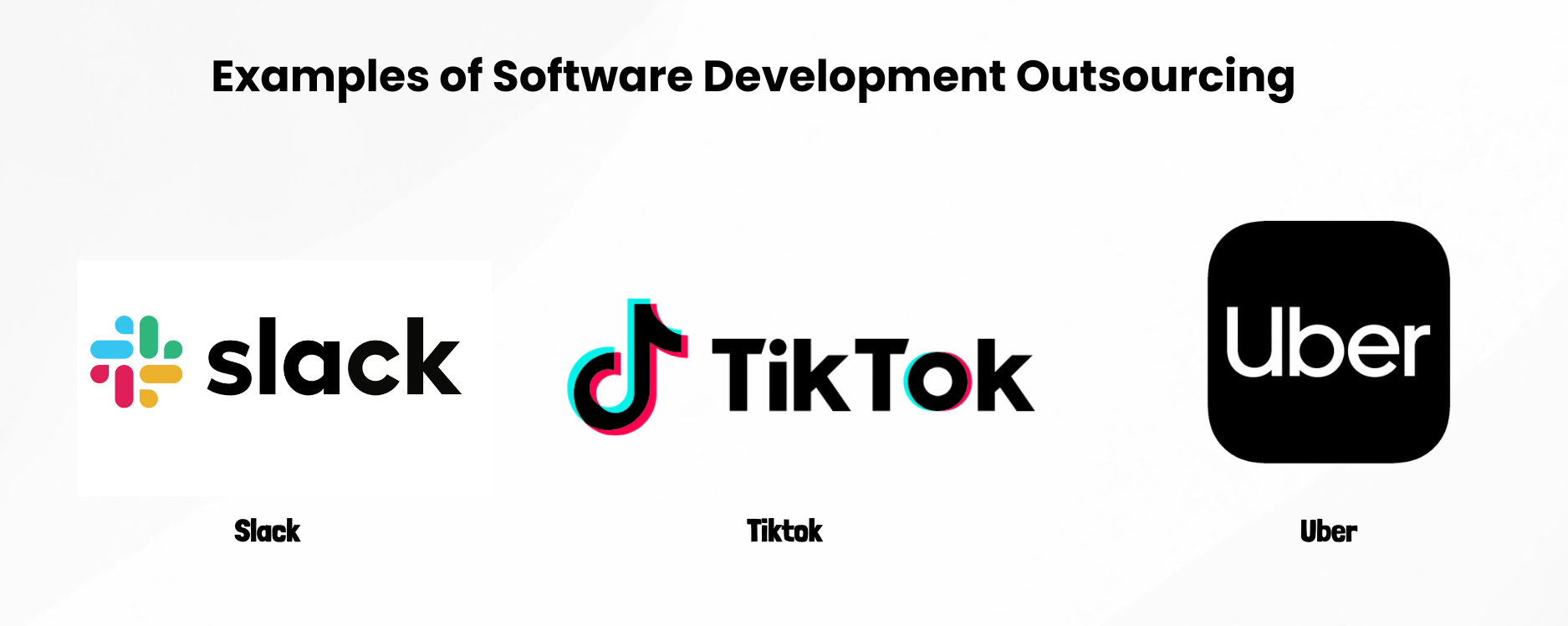
Success stories can serve as inspiration. They show how strategic outsourcing can lead to innovation and growth. These examples highlight how Software Development Outsourcing isn’t just a cost-cutting measure. It’s a strategy that fuels innovation.
1. Slack
You want to revolutionize team communication, but you have limited resources. This was the case for Slack when it first launched. In its early days, Slack outsourced much of its development work to a talented team in the UK. This allowed them to build a robust product quickly without the overhead of hiring a large in-house team.
Fast-forward to today, and Slack has 38.8 million daily active users. It’s like that famous line from The Godfather: “It’s not personal, it’s business.” In this case, Software Development Outsourcing was a smart business decision that propelled them to success.
2. TikTok
In its early days, TikTok outsourced much of its backend development to external teams. This allowed ByteDance to scale its platform rapidly. It was like adding features like real-time video processing, complex AI algorithms for content curation, and global content distribution. An app like TikTok was a success that needed to build massive internal teams.
In 2024, nearly 60% of companies reported outsourcing at least one software development function, with AI and machine learning being top priorities
3. Uber
In its early days, Uber outsourced major portions of its app development, particularly the backend infrastructure, to developers in Eastern Europe. This allowed an app like Uber to quickly integrate real-time GPS tracking, secure payments, and dynamic pricing algorithms—features that became essential to the company’s success.
According to a 2024 report by Deloitte, 70% of fast-growing startups rely on software development outsourcing to manage rapid growth . Uber uxact approach, outsourcing to streamline technical aspects while focusing on market expansion.
So, the next time you hear about a company successfully outsourcing, remember: it’s not just a business decision; it’s a path to innovation and growth. And who knows? Your company could be the next success story to inspire others!
2024-2025 Software Development Outsourcing Trends
Let’s dive into the software development outsourcing trends. We’ll break down each trend with clear, practical examples that show you how to adapt to the changes—and hopefully inspire a few laughs along the way!
AI-Driven Outsourcing
In the old days, outsourcing was like rolling dice. You’d hope to land a good team, but the process was often slow and unpredictable. Enter AI, the matchmaker we didn’t know we needed. Now, companies are turning to AI services not only to find their ideal development partner but also to manage projects, predict delays, and even resolve conflicts.
The takeaway? AI is transforming the way we outsource software development—making it smarter, faster, and way more efficient.
SaaS Development Outsourcing
You know how everyone keeps telling you to “move to the cloud”? It’s like that friend who swears by a new diet every month. But this time, they’re right. Cloud-based SaaS (Software as a Service) solutions are everywhere, and the demand for SaaS development is growing like wildfire. Businesses want software that’s scalable, cost-effective, and always available online.
But here’s the catch: Most companies don’t have the in-house resources to build these complex systems. That’s where SaaS development outsourcing comes in. Instead of creating a SaaS platform from scratch, you can outsource it to experts who do it day in and day out.
So, if you’re looking to build the next big SaaS platform, don’t reinvent the wheel. Leverage outsourcing software development to build secure, scalable cloud-based solutions that can grow with your business.
Quantum Computing Readiness
Now, we’re getting into some sci-fi territory, but stick with me. Quantum computing is no longer just for physicists in labs. It’s becoming a hot topic in the tech world, and companies are starting to prepare for the “quantum leap” (pun intended). Quantum computers can process information exponentially faster than today’s machines, which means software development is about to get a whole lot more complex.
If that sounds overwhelming, don’t worry. Most companies aren’t even close to fully adopting quantum computing yet. But they are preparing for it by outsourcing to teams who specialize in quantum algorithms and post-quantum cryptography.
Increased Focus on Cybersecurity in Outsourcing
A data breach that can cost your company millions. With outsourcing, companies often worry about security risks, especially when sending projects overseas. However, as more projects shift to external partners, the focus on cybersecurity has never been more important.
Luckily, many software outsourcing solutions now come with built-in security protocols. Whether it’s data encryption, two-factor authentication, or secure cloud environments, outsourcing firms are upping their security game. But it’s not just about having security in place; it’s about outsourcing partners who understand the specific threats facing your industry.
The Future is Strategic
The key takeaway for businesses looking to innovate in 2024 is that strategic software development outsourcing isn’t just about reducing costs—it’s about building future-ready, scalable solutions by tapping into global talent and advanced technologies. By embracing hybrid models, aligning with the right partners, and staying ahead of technological trends, companies can leverage outsourcing to drive continuous innovation well into 2025 and beyond.

Outsourcing Developers with TechnBrains
At TechnBrains, outsourcing developers isn’t just about filling temporary gaps—it’s about providing your business with top-tier talent without the hassle and overhead of hiring full-time staff. Whether you need to expand your team’s capabilities for a specific project, bridge a skill gap, or scale your development efforts swiftly, our outsourced development team gives you the flexibility to achieve your goals efficiently.
When you outsource software development through TechnBrains, you’re not just getting a contractor; you’re gaining a strategic partner. Our developers bring expertise across a wide range of technologies, including outsourcing SaaS development and full-stack solutions, ensuring that we match the right talent with your project needs. Whether it’s building a complex system or supporting an existing one, our outsourcing strategy guarantees that your project is delivered on time and within budget.
We also offer ongoing support, so even if you have an in-house team, our outsourced development team can seamlessly integrate and collaborate. Tools like GitHub, Jira, and Trello help both internal and outsourced teams stay aligned, ensuring clear communication and smooth project management. With TechnBrains, software outsource solutions are more than a cost-saving measure—they are a pathway to scaling efficiently and bringing your vision to life with precision and speed.


